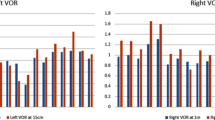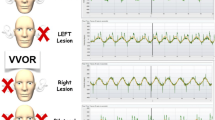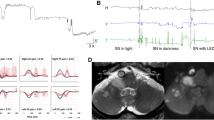Abstract
Abnormalities in the vestibulo-ocular reflex (VOR) after unilateral vestibular injury may cause symptomatic gaze instability. We compared five subjects who had unilateral vestibular lesions with normal control subjects. Gaze stability and VOR gain were measured in three axes using scleral magnetic search coils, in light and darkness, testing different planes of rotation (yaw and pitch), types of stimulus (sinusoids from 0.8 to 2.4 Hz, and transient accelerations) and methods of rotation (active and passive). Eye velocity during horizontal tests reached saturation during high-velocity/acceleration ipsilesional rotation. Rapid vertical head movements triggered anomalous torsional rotation of the eyes. Gaze instability was present even during active rotation in the light, resulting in oscillopsia. These abnormal VOR responses are a consequence of saturating nonlinearities, which limit the usefulness of frequency-domain analysis of rotational test data in describing these lesions.
Similar content being viewed by others
Author information
Authors and Affiliations
Additional information
Received: 22 April 1996 / Accepted: 18 February 1997
Rights and permissions
About this article
Cite this article
Foster, C., Demer, J., Morrow, M. et al. Deficits of gaze stability in multiple axes following unilateral vestibular lesions. Exp Brain Res 116, 501–509 (1997). https://doi.org/10.1007/PL00005778
Issue Date:
DOI: https://doi.org/10.1007/PL00005778




